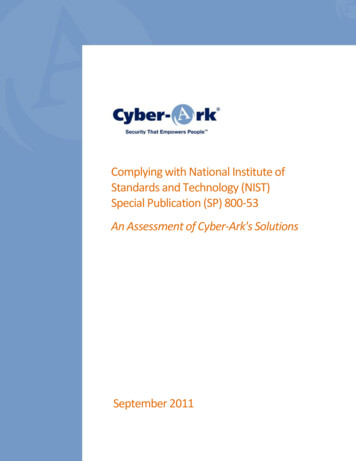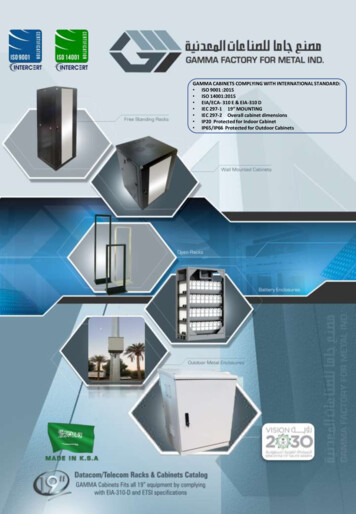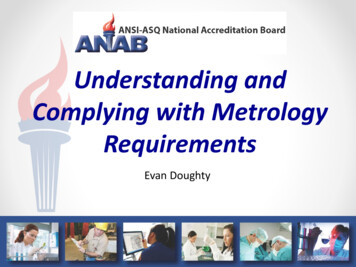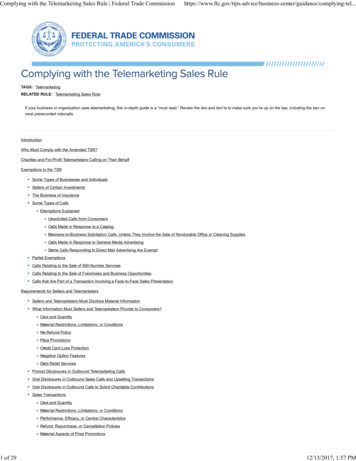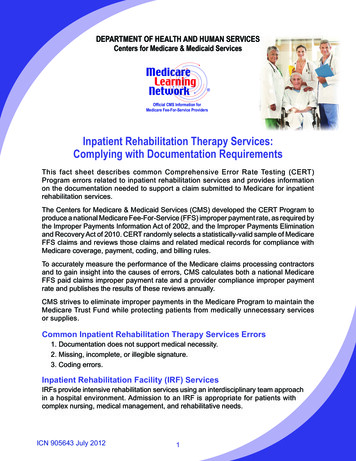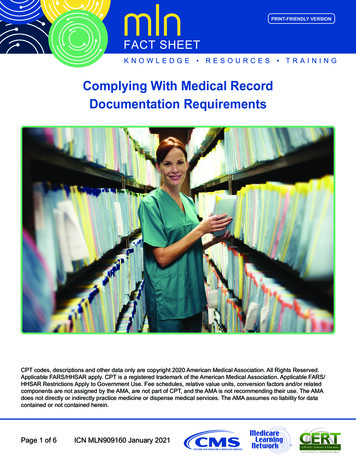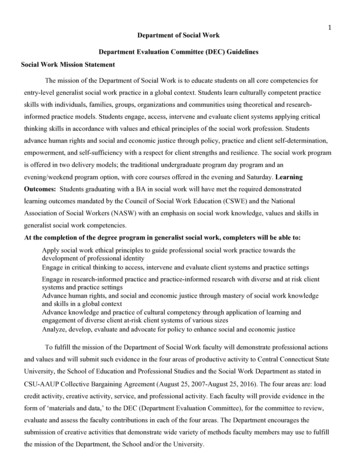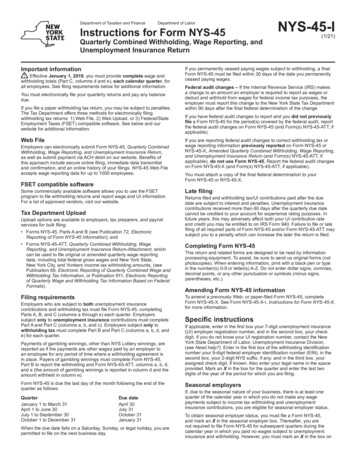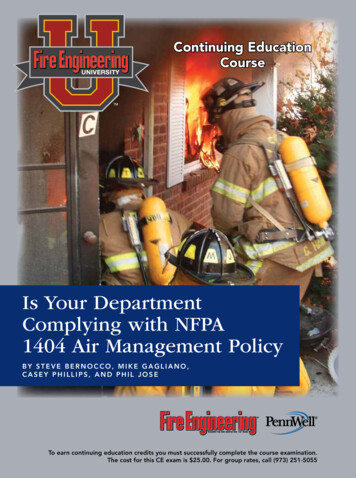
Transcription
Continuing EducationCourseIs Your DepartmentComplying with NFPA1404 Air Management PolicyBY STEVE BERNOCCO, MIKE GAGLIANO,C A S E Y P H I L L I P S , an d P H I L J O S ETRAINING THE FIRE SERVICE FOR 134 YEARSTo earn continuing education credits you must successfully complete the course examination.The cost for this CE exam is 25.00. For group rates, call (973) 251-5055
Is Your Department Complyingwith the NFPA 1404Air Management Policy?Educational ObjectivesOn completion of this course, students will: Identify the basic tenets of NFPA 1404 and air management Identify air management techniques Describe the need for air management Describe methods of putting air management techniquesinto practiceBY STEVE BERNOCCO, MIKE GAGLIANO,C A S E Y P H I L L I P S , an d P H I L J O S EThe topic of air management has becomevery popular over the past several years, and rightly so.Structural firefighters’ actions inside the fire buildingare limited by the air they bring with them on their backs. If afirefighter runs out of air inside the immediately dangerous tolife or health (IDLH) environment, there is a good chance thathe will be seriously injured or killed.In recent months, there have been some excellent articles inthis magazine about emergency breathing techniques firefighters can use when they run low on air; about how importantfirefighters’ air supplies are inside a large “big box” store andwarehouse; and about creating a tradition of safety, in partby managing your air supply based on the size of the firestructure.NFPA 1404All of these points are well made and are importantaspects of air management. However, what seems to be missing in the current discussion of air management is the newsection of National Fire Protection Association (NFPA) 1404,Standard for Fire Service Respiratory Protection Training,which mandates that firefighters be out of the hazard areabefore their low-air alarm activates. And, this begs the ques-(1) Firefighters making an aggressive attack of a structure firethrough the front door. (Photo by Bob Moran.)2 www.FireEngineeringUniversity.comtion: Is your fire department following the air managementpolicy spelled out in the NFPA 1404 standard? If not, yourfire department is not following national standards and couldbe held at fault in a court of law if a firefighter were to beinjured or killed because of the failure to follow the current1
nfpa 1404 2(2) Firefighters raising a ladder to the second floor of an occupied house fire to carry out vent-enter-search (VES). (Photo byLee Calderio.)NFPA standard. We have only to look at the recent, tragicevents in a major East Coast fire department to see what canhappen when the NFPA standards are not followed—in thiscase, NFPA 1403, Standard on Live Fire Training Evolutions.What You Should KnowNFPA 1404 underwent a revision in 2006. The revised standard mandates several significant changes in how firefightersuse their SCBA. The most important changes have to do withthe addition of an individual air management program [NFPA1404, appendix 5.1.4(2)]. The new language states that theindividual air management program shall include the following directives:Exit the IDLH atmosphere BEFORE consumption of thereserve air supply begins.The low-air alarm is notification that the individual isconsuming the reserve air supply.Activation of the low-air warning alarm is an immediateaction item for the individual and team.The revised 1404 standard mandates that firefighters be outof the fire (the IDLH atmosphere) before their low-air warningalarm activates. And, if their low-air warning alarm activateswhile they are inside the hazardous environment, then this isan immediate action item—comparable to a Mayday or firefighter emergency.Think about this: The new standard says that all firefighters must be out of a fire building before their low-air alarmactivates and that a low-air warning alarm going off inside a fireshall be treated with the same urgency as a Mayday. These areimportant changes—necessary changes—you and your department should be following right now, today! If you are not, thenyou are not following national standards and best practices.The reason the NFPA mandates that all firefighters be out ofthe fire building before their low-air alarm activates is that thisgives firefighters an emergency air reserve—the air in the lastquarter of the cylinder—should something go wrong while123they are inside.The fact is that the emergency air reserve was never meantto be used for firefighting. Unfortunately, through poor information, bad habits, and a lack of proper training, the American fire service began using the emergency air reserve foroperational firefighting. However, firefighters should not usethis emergency air for firefighting—it is there only for emergencies. Think of it as your wife’s air, your husband’s air, yoursignificant other’s air, your kids’ air, your parents’ air, yourgrandchildren’s air.Firefighters can and should give three-quarters of the air intheir SCBA cylinder to the citizens they are sworn to protect(photos 1 and 2). However, the remaining quarter cylinder ofair is their air should something bad happen to them whilethey are inside the fire.The scuba diving industry has mandated an emergency airreserve for many decades, and so should we, just as the NFPA1404 standard dictates. There is not really much differencebetween scuba divers underwater and firefighters in an IDLHenvironment: If either of us runs out of air, there is a goodchance we will be seriously injured or killed.COMPLYING WITH NFPA 1404To comply with the NFPA 1404 standard, we believe firefighters should follow the Rule of Air Management, or theROAM, which states: “Know how much air you have in yourSCBA and manage that air so that you leave the hazardousenvironment before your low-air alarm activates.”Following this simple rule will make you and your crewssafer on the fireground by providing you with an emergencyair reserve (photo 3). And, the best part is that the ROAMcosts nothing to implement and use. It is free. You and yourcrew can begin managing your air at your next fire or trainingexercise, and you don’t need to purchase any special equip3(3) A firefighter leaving the IDLH environment before his low-airwarning alarm activates. This firefighter is complying with NFPA1404. (Photo by Lee Calderio.)www.FireEngineeringUniversity.com 3
nfpa 1404ment. There is another added benefit to following the ROAM:By removing the low-air alarm from the fireground, firefighters make this alarm a true emergency alarm, not just anothernoisy false alarm to be ignored.If the American fire service has learned anything over thepast 10 years, it is that we need to manage our air like wemanage the water supply and our crews. We must make surethat we have a full air cylinder before we enter a hazardous environment, we must monitor our air while conductinginterior fire operations, and we must be out of the hazardousenvironment before our low-air warning alarm activates. NFPA1404 mandates that we do this.And so we ask again: Is your fire department following theair-management policy spelled out in the NFPA 1404 standard?Are you and your crews leaving the hazardous environmentbefore your low-air alarm activates? If not, you are out ofcompliance with national standards and might well be settingyourself up for tragedy and heartache.CHANGE AGENTSHow are you going to get your crew, your station, and yourdepartment to come onboard and adopt air management as apractice? Your personal commitment is the best start. You mustbe ready to implement the change and be willing to workwith the resistance that is bound to come from such a proposal that fundamentally changes the way you operate. Hereare some guidelines that may help you, and others, implementthis change within your department.Change is about getting the job done better, safer, andmore effectively. Change that does not improve the“business” of firefighting will eventually fail. We can all citeexamples of proposed changes that went nowhere within ourorganizations, but there are also many that have been successful because they improved the way the job is done. Airmanagement improves the safety and effectiveness of teamsoperating in IDLH environments.Resistors may be your best allies. It’s good to recognize this up front and understand that resistance isnot necessarily a bad thing. It may even help to recognizethat instead of “resisting” the new idea people are “activelypersisting” in the current practice. People get comfortablewith what works. They do not have your vision of how thenew practice will work better than the current one. Oneimportant consideration is that their willingness to questionthe change is an opportunity to make the new practice better and to get their buy-in. Your ability to listen carefully totheir concerns and address them professionally will greatlyimprove your success as a change agent. You will neverknow where your best ally or your biggest foe will comefrom. Keep all your interactions positive. Listen and adaptyour proposals to the input you receive. With all that said,don’t fight battles you can’t win or that cost more than theyachieve. In the rare circumstance that your integrity or yourcrew is on the line, make a stand.Use the department’s informal as well as the formalstructure. The informal structure is founded in the per-1234 www.FireEngineeringUniversity.comsonal relationships you have established within the organization. A good example might be your first company officer ora mentor who has been influential in your career. Get himonboard early, and seek his counsel about ways to move forward. The formal structure consists of written or proceduralmethods of introducing ideas. A good example is a policyrequiring changes in training to be submitted through a committee and approved by the training division chief.Build your support from the bottom up and from thetop down. At all times, look for allies in your effort tochange your organization for the better. See who the otherchange agents are and figure out ways to help them be successful. Give others the credit whenever possible. Make yourdepartment better each day.Create balance and tension. Balance yourself knowing that at the end of the day this is your job, notyour religion. Being right does not require you to berighteous. Recognize that because someone does not agreedoes not mean he is an idiot. The relationships, in theend, are more important than winning an individual battlein your effort to implement change. However, don’t beafraid to create tension. Begin training people in the newpractice. Make air management part of every drill you do.Keep adding weight onto the scale; eventually, it will movein your direction.Change your department; change yourself. Being achange agent will cause you to change. You will belearning, adapting, and growing as you change your department’s practice over to air management. You will have to learnand implement new techniques, develop drills, steer conversations, listen carefully, and ultimately become a different personfrom the one you are today. You cannot force people to signup on the change of practice. People must choose to join youif you hope to have success over the long haul. Implementingair management is just one change you will try to implementover your career. Do it well, and you will be better the nexttime around.456ONE DEPARTMENT CHANGESThe Seattle (WA) Fire Department converted to an airmanagement department, culminating with formal policyimplementation in 2004. This change, achieved over a span ofapproximately three years, was the result of a multiprongedapproach.Seattle made the change to air management, and the practice of requiring firefighters to exit the IDLH environmentbefore the low-air alarm activates is working today—rightnow. We rarely hear a low-air alarm on our fireground. Whenwe do, it necessitates a radio report to identify the source ofthe alarm and the status of the firefighters involved.How did we get here? Part one of the process was to introduce air management into the operations-level training provided each year. We have a program currently labeled “Operational Skills Enhancement Training (OSET),” which providesannual training on structural firefighting skills. Several peopleon the development team were committed to bringing an air
nfpa 1404 management philosophy to the department and were successful in getting basic air management skills incorporated intothe OSET program.Initially, air management was presented as a single skillstation (out of four skill stations) offered during an eight-hourhands-on training day. In subsequent years, an ever-increasingair management component was added to more of the skillstations. Eventually, air management became an integral partof the entire OSET program. The department was even able tosecure grant funding to provide air management training asa component of the training on newly purchased SCBA with45-minute/1,800-liter cylinders.A second part of the process was a commitment fromthe chief of the department at the time, Chief Gary Morris. Having come from Phoenix and experiencing the deathof Firefighter Brett Tarver in the Southwest Supermarket inPhoenix, Morris was committed to bringing the lessons ofthat experience to Seattle. One of the primary recommendations of the National Institute for Occupational Safety andHealth (NIOSH) in its report on the death of Brett Tarver(NIOSH FACE Report 2001-13) was that fire departmentsshould “ensure that firefighters manage their air supplies aswarranted by the size of the structure involved.” With this inmind, Morris supported the bottom-up approach used in theOSET program.The third part of the process to change Seattle Fire into anair management department came from two forces. The firstwas that Seattle had a string of situations in which firefighters required medical care as a result of overheating anddehydration. These incide
NFPA 1404 underwent a revision in 2006. the revised stan-dard mandates several significant changes in how firefighters use their sCbA. the most important changes have to do with the addition of an individual air management program [NFPA 1404, appendix 5.1.4(2)]. the new language states that the individual air management program shall include the follow- ing directives: 1exit the IDLh .
